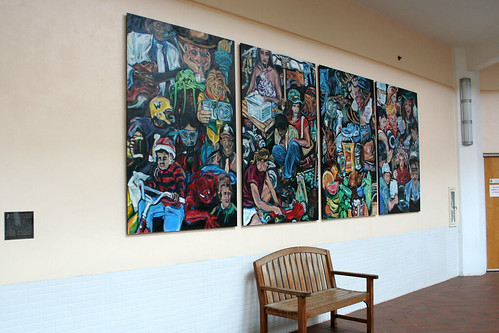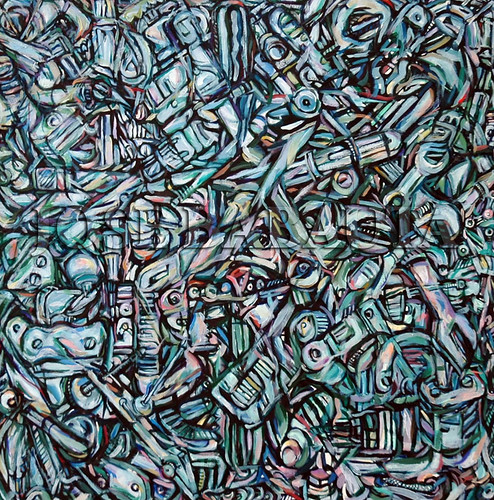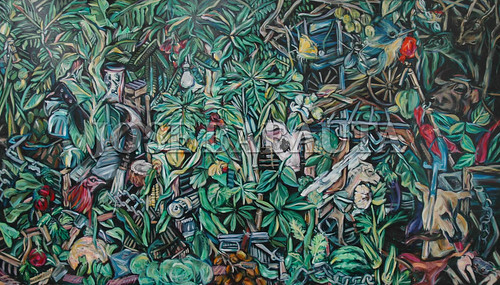Jose J. Babauta
Weaver of images
Jose J. Babauta (1952 – 2015) was a painter and art professor at the University of Guam. Babauta, born in Hågat and raised in Piti, typically painted large canvases, though he was known to produce miniatures and pen and ink drawings as well.
Babauta was the oldest son of Lucia Tajalle Babauta, originally from Sumai. Lucia moved to Hågat after World War II and had nine children. Babauta, born in 1952, was the third. When Babauta was eight years old his mother became ill and the family suffered years of hard times back in the days when there were little social services on island. Eventually some of the children where raised (poksai) by various relatives, godparents and friends. Lucia and some of the children moved in with Lucia’s brother, Mariano Tajalle, and his large family in Piti where they lived until Lucia died of Lytico-Bodig (Lytico-Bodig disease is a neurological disease that exists on Guam. It resembles Amyotrophic lateral sclerosis (ALS)–more commonly known as Lou Gehrig’s disease–Parkinson’s Disease, and Alzheimer’s) when Babauta was 12 years old. Babauta stayed with members of his uncle and aunt’s family in Piti until he graduated from high school.
These early years of hardship and loss, coupled with rapid cultural change on Guam, provided Babauta with strong emotions about family, loss and struggle. Fortunately, Babauta was a good student and showed artistic talent, and was determined to attend college and become a professional though no one else in his family had done so. He worked his way through college as a draftsman, occasionally taking other jobs to support his family as well. At first he studied architecture, thinking it would be more lucrative, but then switched his major to art which was always his secret true love.
Babauta attended the University of Guam right out of high school in 1970, then went stateside to Portland State, and finally the University of Washington where he graduated with a Bachelor of Fine Arts in 1982. Later, he earned a Master of Fine Arts at San Francisco State in 1988.
He was hired by the University of Guam to teach art in 1990 and worked there as a tenured Associate Professor of art, teaching classes in art history, life drawing and painting until his retirement in late 2014. He died after a short illness on 6 January 2015 while visiting family in California.
Babauta believed his artistic sensibilities hailed from his Chamorro ancestors as well as from modern artists worldwide. He strove to communicate a modern islander identity by refreshing the sense of weaving by entangling images of industrialized objects in his paintings rather than the palm fronds used so abundantly in times past. This weaving of images allowed for a blending of both modern and traditional cultures to coalesce and present a modern style with a Pacific Islander feel.
Babauta considered himself a modern day weaver. He was inspired by the transitions that Chamorros went through from traditional to modern, explaining that the gradual loss of natural items that were so familiar to Chamorros (woven items and coconut shell containers) and their replacement with modern manmade items triggered a caution in him. He sensed that his identity was being threatened with this modernization of Guam which is critical to defining who he was and where he was from. Babauta said this rapid change made him feel culturally diminished.
This loss, however, stimulated his desire for cultural preservation. Babauta believed that while going back to the old ways may be impossible, people could resist the changes which emboldened his own island spirit. Babauta painted with the intention of refreshing the traditional with a sensibility characteristic of the contemporary Pacific. He expressed himself by using forms from the commercial environment, replacing the real with the visual and wove them together with pictures.
Babauta’s work can be seen at the Guam International Airport, University of Guam and Superior Court of Guam. A large mural about the University of Guam programs by Babauta and his art students can be seen along Route 10 in Mangilao.
He also created an Urban Jungle series as a social and cultural commentary on the contemporary environment of Guam. One of the pieces, the Urban Jungle pen and ink sketch, has several familiar images and icons, such as the Statue of Liberty, Disney characters, cigarette and fast food logos. Common tools such as paintbrushes, pencils, pens, scissors, thumbtacks, utility knives, rulers, clamps, safety pins, hair pins can be found in the drawing. Also seen are bicycle chains, clocks, architecture, machines, a gun and a train. A plastic fork appears in the lower right corner, as Babauta’s comment on consumerism. He described how the tradition of fiestas have changed on Guam, from woven baskets to aluminum foil to plastic containers.
In another piece from this series, Babauta pieced together layers of commercial imagery like a mat (guafak) woven from palm fronds, thus encouraging viewers to investigate how the bombardment of commercial images and consumerism has shaped them. Babauta continually questioned issues of modern Chamorro identity, as traditional life ways evolve to more of a consumer culture shaded with islander overtones. Babauta’s art encourages viewers to consider these changes.
Babauta had seven children (Leo, Katrina, Ana, Tiara, Joseph, Brandon and Austin) and many grandchildren (Chloe, Justin, Samantha, Rain, Maia, Lennon, Isabella, Seth, Noelle, Caillie Jean, Joey Lucia and Aliana as of 2021).
For further reading
Guam Council on the Arts and Humanities Agency. “Artists – Guam CAHA.”
Humanities Guåhan. Picturing Guam Teachers Resource Book. Hagåtña: HG, 2011.
I Manfayi: Who’s Who in Chamorro History. VoI. 3. The Hale’-ta Series. Hagåtña: Department of Chamorro Affairs, Division of Research, Publication, and Training, 2002.
Leon-Guerrero, Jillette. Seeing Guam Through Our Eyes. Agana Heights: Guamology Publishing, 2010.






